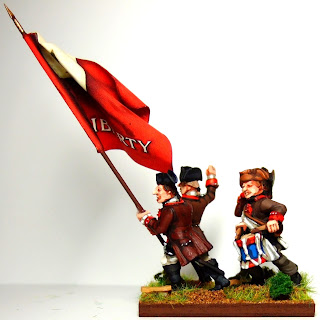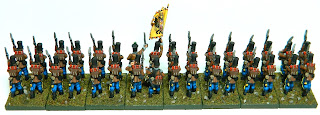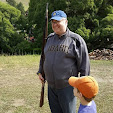I finished the last of the scatter this afternoon, and these troops are ready for your viewing pleasure. I bought five bags of infantry and one bag of artillery, so I have 158 foot and two guns here.
These are six regiments of infantry and two stands of artillery, all castings from Old Glory's old range. I found these figures adequate, but I would not choose them over Perry, Fife and Drum, or Old Glory's second edition. I paid $108 for these figures, so I certainly got a lot of lead for the money. With one bag of skirmishers and one bag of mounted generals, I could have fielded a nice starter army for under $150. That is Old Glory's great strength: adequate troops for very little money.
These are filler for my army, and I painted them as such. I started them on December 10th and finished on December 28th, so I was definitely painting quickly. Still, I varied the uniforms quite a bit, using five different shades of brown for the coats, 11 different colors for gaiters / stockings / overalls, and seven different colors for hats. I like my Continentals to look motley, and these come close. If I could have mixed in civilian coats, shirtsleeves, and fringed hunting shirts, as I did with my Perry regiments, I would have been even happier.
Generic Brown Regiment #1 26 figures
Generic Brown Regiment #2 26 figures
Generic Brown Regiment #3 26 figures
Generic Brown Regiment #4 24 figures
If the Continentals ever really had a standard jacket color, it was not the dark blue of our schoolbook illustrations. The blue coat was only adopted in 1778, when all the northern battles were over, and it is unlikely that blue was ever widely worn. The American army had supply troubles all through the war, and I imagine that any serviceable clothing would have been acceptable to army quartermasters.
In short, the Continental army was brown, brown, brown. These four regiments can stand in for almost any unit, any time.
Generic Blue Regiment with Red Facings 24 figures
Generic Blue Regiment with White Facings 24 figures
Of course, some units would have worn blue, so these two regiments represent my nod to the quartermasters. The unit with white facings has even been able to secure white leg wear for most of the men. I have still included some brown coats.
Generic Continental Artillery
This was the standard artillery uniform for both sides: blue coat, red facings. I painted them with drab gaiters to match my drab army.
Lamb's New York Artillery Company
I saw this uniform in Mollo / McGregor, and I liked the idea of trying something other than the standard red faced blue coat.
So there you have it. Enough figures for a decent game, at least for one side. $108, 160 castings, 18 days.
Now if I can ever get going on the British, I may actually be able to fight an American Revolution battle someday. I have enough bare lead to get a scrap going, but I cannot prime them until the weather cooperates! I does look like it's supposed to get above freezing here on Monday, and we all know that weather forecasts are never wrong!





























































